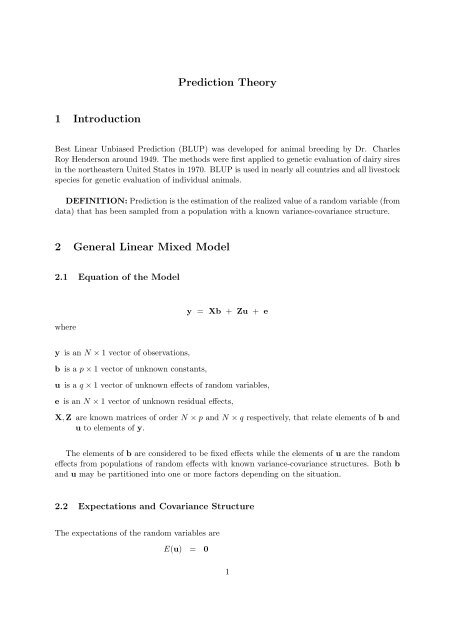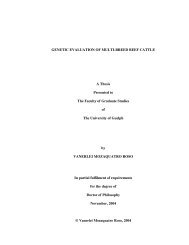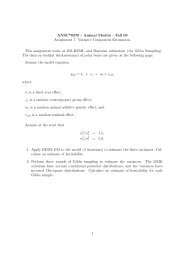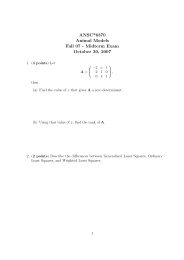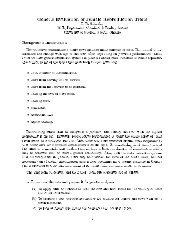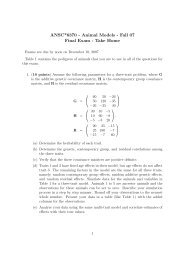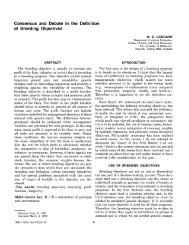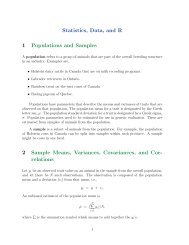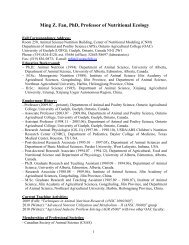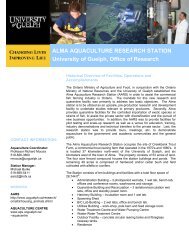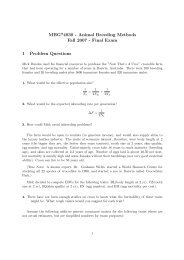Prediction Theory 1 Introduction 2 General Linear Mixed Model
Prediction Theory 1 Introduction 2 General Linear Mixed Model
Prediction Theory 1 Introduction 2 General Linear Mixed Model
Create successful ePaper yourself
Turn your PDF publications into a flip-book with our unique Google optimized e-Paper software.
<strong>Prediction</strong> <strong>Theory</strong><br />
1 <strong>Introduction</strong><br />
Best <strong>Linear</strong> Unbiased <strong>Prediction</strong> (BLUP) was developed for animal breeding by Dr. Charles<br />
Roy Henderson around 1949. The methods were first applied to genetic evaluation of dairy sires<br />
in the northeastern United States in 1970. BLUP is used in nearly all countries and all livestock<br />
species for genetic evaluation of individual animals.<br />
DEFINITION: <strong>Prediction</strong> is the estimation of the realized value of a random variable (from<br />
data) that has been sampled from a population with a known variance-covariance structure.<br />
2 <strong>General</strong> <strong>Linear</strong> <strong>Mixed</strong> <strong>Model</strong><br />
2.1 Equation of the <strong>Model</strong><br />
where<br />
y = Xb + Zu + e<br />
y is an N × 1 vector of observations,<br />
b is a p × 1 vector of unknown constants,<br />
u is a q × 1 vector of unknown effects of random variables,<br />
e is an N × 1 vector of unknown residual effects,<br />
X, Z are known matrices of order N × p and N × q respectively, that relate elements of b and<br />
u to elements of y.<br />
The elements of b are considered to be fixed effects while the elements of u are the random<br />
effects from populations of random effects with known variance-covariance structures. Both b<br />
and u may be partitioned into one or more factors depending on the situation.<br />
2.2 Expectations and Covariance Structure<br />
The expectations of the random variables are<br />
E(u) = 0<br />
1
E(e) = 0<br />
E(y) = E(Xb + Zu + e)<br />
= E(Xb) + E(Zu) + E(e)<br />
= XE(b) + ZE(u) + E(e)<br />
= Xb + Z0 + 0<br />
= Xb<br />
and the variance-covariance structure is typically represented as<br />
( ) ( )<br />
u G 0<br />
V =<br />
,<br />
e 0 R<br />
where G and R are known, positive definite matrices. Consequently,<br />
V ar(y) = V ar(Xb + Zu + e)<br />
Cov(y, u) = ZG<br />
Cov(y, e) = R<br />
= V ar(Zu + e)<br />
= ZV ar(u)Z ′ + V ar(e) + ZCov(u, e) + Cov(e, u)Z ′<br />
= ZGZ ′ + R, and<br />
If u is partitioned into s factors as<br />
u ′ =<br />
(<br />
u ′ 1 u ′ 2 · · · u ′ s<br />
)<br />
,<br />
then<br />
⎛<br />
V ar(u) = V ar<br />
⎜<br />
⎝<br />
Each G ij is assumed to be known.<br />
u 1<br />
u 2<br />
.<br />
u s<br />
⎞ ⎛<br />
⎟ = ⎜<br />
⎠ ⎝<br />
⎞<br />
G 11 G 12 · · · G 1s<br />
G ′ 12 G 22 · · · G 2s<br />
.<br />
. . .. ⎟ .<br />
. ⎠<br />
G ′ 1s G ′ 2s · · · G ss<br />
3 Predictors<br />
The problem is to predict the function<br />
provided that K ′ b is an estimable function.<br />
K ′ b + M ′ u,<br />
2
3.1 Best Predictor<br />
The best predictor, for any type of model, requires knowledge of the distribution of the random<br />
variables as well as the moments of that distribution. Then, the best predictor is the conditional<br />
mean of the predictor given the data vector, i.e.<br />
E(K ′ b + M ′ u|y)<br />
which is unbiased and has the smallest mean squared error of all predictors (Cochran 1951).<br />
The computational form of the predictor depends on the distribution of y. The computational<br />
form could be linear or nonlinear. The word best means that the predictor has the smallest<br />
mean squared error of all predictors of K ′ b + M ′ u.<br />
3.2 Best <strong>Linear</strong> Predictor<br />
The best predictor may be linear OR nonlinear. Nonlinear predictors are often difficult to<br />
manipulate or to derive a feasible solution. The predictor could be restricted to class of linear<br />
functions of y. Then, the distributional form of y does not need to be known, and only the first<br />
(means) and second (variances) moments of y must be known. If the first moment is Xb and<br />
the second moment is V ar(y) = V, then the best linear predictor is<br />
where<br />
E(K ′ b + M ′ u) = K ′ b + C ′ V −1 (y − Xb)<br />
C ′<br />
= Cov(K ′ b + M ′ u, y).<br />
When y has a multivariate normal distribution, then the best linear predictor (BLP) is the<br />
same as the best predictor (BP). The BLP has the smallest mean squared error of all linear<br />
predictors of K ′ b + M ′ u.<br />
3.3 Best <strong>Linear</strong> Unbiased Predictor<br />
In general, the first moment of y, namely Xb, is not known, but V, the second moment, is<br />
commonly assumed to be known. Then predictors can be restricted further to those that are<br />
linear and also unbiased. The best linear unbiased predictor is<br />
where<br />
and C and V are as before.<br />
K ′ˆb + C ′ V −1 (y − Xˆb)<br />
ˆb = (X ′ V −1 X) − X ′ V −1 y,<br />
This predictor is the same as the BLP except that ˆb has replaced b in the formula. Note<br />
that ˆb is the GLS estimate of b. Of all linear, unbiased predictors, BLUP has the smallest<br />
mean squared error. However, if y is not normally distributed, then nonlinear predictors of<br />
K ′ b + M ′ u could potentially exist that have smaller mean squared error than BLUP.<br />
3
4 Derivation of BLUP<br />
4.1 Predictand and Predictor<br />
DEFINITION: The predictand is the function to be predicted, in this case<br />
K ′ b + M ′ u.<br />
DEFINITION: The predictor is the function to predict the predictand, a linear function of y,<br />
i.e. L ′ y, for some L.<br />
4.2 Requiring Unbiasedness<br />
Equate the expectations of the predictor and the predictand to determine what needs to be true<br />
in order for unbiasedness to hold. That is,<br />
then to be unbiased for all possible vectors b,<br />
E(L ′ y) = L ′ Xb<br />
E(K ′ b + M ′ u) = K ′ b<br />
L ′ X = K ′<br />
or<br />
L ′ X − K ′ = 0.<br />
4.3 Variance of <strong>Prediction</strong> Error<br />
The prediction error is the difference between the predictor and the predictand. The covariance<br />
matrix of the prediction errors is<br />
V ar(K ′ b + M ′ u − L ′ y) = V ar(M ′ u − L ′ y)<br />
= M ′ V ar(u)M + L ′ V ar(y)L<br />
−M ′ Cov(u, y)L − L ′ Cov(y, u)M<br />
= M ′ GM + L ′ VL − M ′ GZ ′ L − L ′ ZGM<br />
= V ar(P E)<br />
4
4.4 Function to be Minimized<br />
Because the predictor is required to be unbiased, then the mean squared error is equivalent<br />
to the variance of prediction error. Combine the variance of prediction error with a LaGrange<br />
Multiplier to force unbiasedness to obtain the matrix F, where<br />
F = V ar(P E) + (L ′ X − K ′ )Φ.<br />
Minimization of the diagonals of F is achieved by differentiating F with respect to the unknowns,<br />
L and Φ, and equating the partial derivatives to null matrices.<br />
∂F<br />
∂L<br />
= 2VL − 2ZGM + XΦ = 0<br />
∂F<br />
∂Φ = X′ L − K = 0<br />
Let θ = .5Φ, then the first derivative can be written as<br />
then solve for L as<br />
VL = ZGM − Xθ<br />
V −1 VL = L<br />
= V −1 ZGM − V −1 Xθ.<br />
Substituting the above for L into the second derivative, then we can solve for θ as<br />
X ′ L − K = 0<br />
X ′ (V −1 ZGM − V −1 Xθ) − K = 0<br />
X ′ V −1 Xθ = X ′ V −1 ZGM − K<br />
Substituting this solution for θ into the equation for L gives<br />
θ = (X ′ V −1 X) − (X ′ V −1 ZGM − K)<br />
L ′ = M ′ GZ ′ V −1 + K ′ (X ′ V −1 X) − X ′ V −1<br />
−M ′ GZ ′ V −1 X(X ′ V −1 X) − X ′ V −1 .<br />
Let<br />
ˆb = (X ′ V −1 X) − X ′ V −1 y,<br />
then the predictor becomes<br />
L ′ y = K ′ˆb + M ′ GZ ′ V −1 (y − Xˆb)<br />
which is the BLUP of K ′ b + M ′ u, and ˆb is a GLS solution for b. A special case for this predictor<br />
would be to let K ′ = 0 and M ′ = I, then the predictand is K ′ b + M ′ u = u, and<br />
L ′ y = û = GZ ′ V −1 (y − Xˆb).<br />
( )<br />
Hence the predictor of K ′ b + M ′ u is K ′ M ′ times the predictor of<br />
(<br />
ˆb′ û ′ ) ′<br />
.<br />
5<br />
(<br />
b ′<br />
u ′ ) ′<br />
which is
5 Variances of Predictors<br />
Let<br />
then<br />
P = (X ′ V −1 X) −<br />
ˆb = PX ′ V −1 y<br />
û = GZ ′ V −1 (y − XPX ′ V −1 y)<br />
= GZ ′ V −1 Wy<br />
for W = (I − XPX ′ V −1 ). From the results on generalized inverses of X,<br />
and therefore,<br />
The variance of the predictor is,<br />
The covariance between ˆb and û is<br />
XPX ′ V −1 X = X,<br />
WX = (I − XPX ′ V −1 )X<br />
= X − XPX ′ V −1 X<br />
= X − X = 0.<br />
V ar(û) = GZ ′ V −1 W(V ar(y))W ′ V −1 ZG<br />
= GZ ′ V −1 WVW ′ V −1 ZG<br />
Therefore, the total variance of the predictor is<br />
= GZ ′ V −1 ZG − GZ ′ V −1 XPX ′ V −1 ZG.<br />
Cov(ˆb, û) = PX ′ V −1 V ar(y)W ′ V −1 ZG<br />
= PX ′ W ′ V −1 ZG<br />
= 0 because X ′ W = 0<br />
V ar(K ′ˆb + M ′ û) = K ′ PK + M ′ GZ ′ V −1 ZGM<br />
−M ′ GZ ′ V −1 XPX ′ V −1 ZGM.<br />
6 Variance of <strong>Prediction</strong> Error<br />
The main results are<br />
V ar(ˆb − b) = V ar(ˆb) + V ar(b) − Cov(ˆb, b) − Cov(b, ˆb)<br />
= V ar(ˆb)<br />
= P.<br />
V ar(û − u) = V ar(û) + V ar(u) − Cov(û, u) − Cov(u, û),<br />
6
where<br />
Cov(û, u) = GZ ′ V −1 WCov(y, u)<br />
= GZ ′ V −1 WZG<br />
= GZ ′ (V −1 − V −1 XPX ′ V −1 )ZG<br />
= V ar(û)<br />
so that<br />
V ar(û − u) = V ar(û) + G − 2V ar(û)<br />
= G − V ar(û).<br />
Also,<br />
Cov(ˆb, û − u) = Cov(ˆb, û) − Cov(ˆb, u)<br />
= 0 − PX ′ V −1 ZG.<br />
7 <strong>Mixed</strong> <strong>Model</strong> Equations<br />
The covariance matrix of y is V which is of order N. N is usually too large to allow V to<br />
be inverted. The BLUP predictor has the inverse of V in the formula, and therefore, would<br />
not be practical when N is large. Henderson(1949) developed the mixed model equations for<br />
computing BLUP of u and the GLS of b. However, Henderson did not publish a proof of these<br />
properties until 1963 with the help of S. R. Searle, which was one year after Goldberger (1962).<br />
Take the first and second partial derivatives of F,<br />
( ) ( )<br />
V X L<br />
X ′ =<br />
0 θ<br />
Recall that V = V ar(y) = ZGZ ′ + R, and let<br />
(<br />
ZGM<br />
K<br />
)<br />
which when re-arranged gives<br />
S = G(Z ′ L − M)<br />
M = Z ′ L − G −1 S,<br />
then the previous equations can be re-written as<br />
⎛<br />
⎞ ⎛<br />
R X Z<br />
⎜<br />
⎝ X ′ ⎟ ⎜<br />
0 0 ⎠ ⎝<br />
Z ′ 0 −G −1<br />
L<br />
θ<br />
S<br />
⎞<br />
⎟<br />
⎠ =<br />
⎛<br />
⎜<br />
⎝<br />
0<br />
K<br />
M<br />
⎞<br />
⎟<br />
⎠ .<br />
Take the first row of these equations and solve for L, then substitute the solution for L into<br />
the other two equations.<br />
L = −R −1 Xθ − R −1 ZS<br />
7
and<br />
( ) ( )<br />
X<br />
−<br />
′ R −1 X X ′ R −1 Z<br />
θ<br />
Z ′ R −1 X Z ′ R −1 Z + G −1 S<br />
=<br />
(<br />
K<br />
M<br />
Let a solution to these equations be obtained by computing a generalized inverse of<br />
(<br />
X ′ R −1 X X ′ R −1 Z<br />
Z ′ R −1 X Z ′ R −1 Z + G −1 )<br />
denoted as ( )<br />
Cxx C xz<br />
,<br />
C zx C zz<br />
then the solutions are<br />
Therefore, the predictor is<br />
L ′ y =<br />
=<br />
(<br />
θ<br />
S<br />
(<br />
(<br />
)<br />
= −<br />
(<br />
Cxx C xz<br />
C zx C zz<br />
) (<br />
K<br />
M<br />
) ( ) (<br />
K ′ M ′ C xx C xz X ′ R −1 y<br />
C zx C zz Z ′ R −1 y<br />
) ( ) ˆb<br />
K ′ M ′ ,<br />
û<br />
)<br />
.<br />
)<br />
)<br />
.<br />
where ˆb and û are solutions to<br />
( ) (<br />
X ′ R −1 X X ′ R −1 Z<br />
ˆb<br />
Z ′ R −1 X Z ′ R −1 Z + G −1 û<br />
)<br />
=<br />
(<br />
X ′ R −1 y<br />
Z ′ R −1 y<br />
)<br />
.<br />
The equations are known as Henderson’s <strong>Mixed</strong> <strong>Model</strong> Equations or MME. The equations are<br />
of order equal to the number of elements in b and u, which is usually much less than the number<br />
of elements in y, and therefore, are more practical to solve. Also, these equations require the<br />
inverse of R rather than V, both of which are of the same order, but R is usually diagonal or<br />
has a more simple structure than V. Also, the inverse of G is needed, which is of order equal<br />
to the number of elements in u. The ability to compute the inverse of G depends on the model<br />
and the definition of u.<br />
The MME are a useful computing algorithm for obtaining BLUP of K ′ b + M ′ u. Please keep<br />
in mind that BLUP is a statistical procedure such that if the conditions for BLUP are met,<br />
then the predictor has the smallest mean squared error of all linear, unbiased predictors. The<br />
conditions are that the model is the true model and the variance-covariance matrices of the<br />
random variables are known without error.<br />
In the strictest sense, all models approximate an unknown true model, and the variancecovariance<br />
parameters are usually guessed, so that there is never a truly BLUP analysis of data,<br />
except possibly in simulation studies.<br />
8
8 Equivalence Proofs<br />
The equivalence of the BLUP predictor to the solution from the MME was published by Henderson<br />
in 1963. In 1961 Henderson was in New Zealand (on sabbatical leave) visiting Shayle<br />
Searle learning matrix algebra and trying to derive the proofs in this section. Henderson needed<br />
to prove that<br />
V −1 = R −1 − R −1 ZTZ ′ R −1<br />
where<br />
and<br />
T = (Z ′ R −1 Z + G −1 ) −1<br />
V = ZGZ ′ + R.<br />
Henderson says he took his coffee break one day and left the problem on Searle’s desk, and when<br />
he returned from his coffee break the proof was on his desk.<br />
VV −1 = (ZGZ ′ + R)(R −1 − R −1 ZTZ ′ R −1 )<br />
= ZGZ ′ R −1 + I − ZGZ ′ R −1 ZTZ ′ R −1<br />
−ZTZ ′ R −1<br />
= I + (ZGT −1 − ZGZ ′ R −1 Z − Z)<br />
TZ ′ R −1<br />
= I + (ZG(Z ′ R −1 Z + G −1 )<br />
−ZGZ ′ R −1 Z − Z)TZ ′ R −1<br />
= I + (ZGZ ′ R −1 Z + Z<br />
−ZGZ ′ R −1 Z − Z)TZ ′ R −1<br />
= I + (0)TZ ′ R −1<br />
= I.<br />
Now take the equation for û from the MME<br />
Z ′ R −1 Xˆb + (Z ′ R −1 Z + G −1 )û = Z ′ R −1 y<br />
which can be re-arranged as<br />
(Z ′ R −1 Z + G −1 )û = Z ′ R −1 (y − Xˆb)<br />
or<br />
The BLUP formula was<br />
û = TZ ′ R −1 (y − Xˆb).<br />
û = GZ ′ V −1 (y − Xˆb).<br />
9
Then<br />
GZ ′ V −1 = GZ ′ (R −1 − R −1 ZTZ ′ R −1 )<br />
= (GZ ′ R −1 − GZ ′ R −1 ZTZ ′ R −1 )<br />
= (GT −1 − GZ ′ R −1 Z)TZ ′ R −1<br />
= (G(Z ′ R −1 Z + G −1 ) − GZ ′ R −1 Z)TZ ′ R −1<br />
= TZ ′ R −1 .<br />
Similarly, the MME solution for û and substituting it into the first equation in the MME<br />
gives<br />
X ′ R −1 Xˆb + X ′ R −1 Z(TZ ′ R −1 (y − Xˆb)) = X ′ R −1 y.<br />
Combine the terms in ˆb and y to give<br />
X ′ (R −1 − R −1 ZTZ ′ R −1 )Xˆb = X ′ (R −1 − R −1 ZTZ ′ R −1 )y,<br />
which are the same as the GLS equations,<br />
X ′ V −1 Xˆb = X ′ V −1 y.<br />
Goldberger (1962) published these results before Henderson (1963), but Henderson knew of<br />
these equivalences back in 1949 through numerical examples. After he discovered Goldberger’s<br />
paper (sometime after his retirement) Henderson insisted on citing it along with his work. Most<br />
people in animal breeding, however, refer to Henderson as the originator of this work and its<br />
primary proponent.<br />
9 Variances of Predictors and <strong>Prediction</strong> Errors From MME<br />
The covariance matrices of the predictors and prediction errors can be expressed in terms of the<br />
generalized inverse of the coefficient matrix of the MME, C. Recall that<br />
( ) ( ) ( )<br />
ˆb Cxx C<br />
=<br />
xz X ′ R −1<br />
û C zx C zz Z ′ R −1 y,<br />
or as<br />
ˆb = C ′ by,<br />
and<br />
û = C ′ uy.<br />
If the coefficient matrix of the MME is full rank (or a full rank subset) (to simplify the<br />
presentation of results), then<br />
( ) ( ) ( )<br />
Cxx C xz X ′ R −1 X X ′ R −1 Z<br />
I 0<br />
C zx C zz Z ′ R −1 X Z ′ R −1 Z + G −1 =<br />
,<br />
0 I<br />
10
which gives the result that<br />
( ) (<br />
Cxx C xz X ′ R −1 X X ′ R −1 Z<br />
C zx C zz Z ′ R −1 X Z ′ R −1 Z<br />
=<br />
( )<br />
I −Cxz G −1<br />
0 I − C zz G −1 .<br />
This last result is used over and over in deriving the remaining results.<br />
Now,<br />
V ar(ˆb) = V ar(C ′ by)<br />
= C ′ bV ar(y)C b<br />
= C ′ b(ZGZ ′ + R)C b<br />
(<br />
) ( )<br />
X<br />
= C xx C ′ R −1<br />
xz<br />
Z ′ R −1 (ZGZ ′ + R)C b<br />
(<br />
) ( )<br />
X<br />
= C xx C ′ R −1 Z<br />
xz<br />
Z ′ R −1 GZ ′ C<br />
Z<br />
b<br />
(<br />
+<br />
C xx C xz<br />
) ( X ′<br />
Z ′ )<br />
C b<br />
)<br />
= −C xz G −1 GZ ′ C b<br />
(<br />
) ( X<br />
+ C xx C ′ R −1 X X ′ R −1 Z<br />
xz<br />
Z ′ R −1 X Z ′ R −1 Z<br />
) ( )<br />
Cxx<br />
C zx<br />
= C xz G −1 C zx<br />
(<br />
) ( )<br />
+ I −C xz G −1 C xx<br />
C zx<br />
= C xz G −1 C zx + C xx − C xz G −1 C zx<br />
= C xx .<br />
The remaining results are derived in a similar manner. These give<br />
V ar(û) = C u ′ V ar(y)C u<br />
= G − C zz<br />
Cov(ˆb, û) = 0<br />
V ar(û − u) = V ar(û) + V ar(u) − Cov(û, u) − Cov(u, û)<br />
= V ar(u) − V ar(û)<br />
= G − (G − C zz )<br />
= C zz<br />
11
Cov(ˆb, û − u) = Cov(ˆb, u)<br />
= C xz<br />
In matrix form, the variance-covariance matrix of the predictors is<br />
( ) ( )<br />
ˆb Cxx 0<br />
V ar =<br />
,<br />
û 0 G − C zz<br />
and the variance-covariance matrix of prediction errors is<br />
( ) ( )<br />
ˆb<br />
Cxx C<br />
V ar<br />
=<br />
xz<br />
.<br />
û − u C zx C zz<br />
As the number of observations in the analysis increases, two things can be noted from these<br />
results:<br />
1. V ar(û) increases in magnitude towards a maximum of G, and<br />
2. V ar(û − u) decreases in magnitude towards a minimum of 0.<br />
10 Hypothesis Testing<br />
When G and R are assumed known, as in BLUP, then the solutions for ˆb from the MME<br />
are BLUE and tests of hypotheses that use these solutions are best. Tests involving û are<br />
unnecessary because when G and R have been assumed to be known, then the variation due<br />
to the random factors has already been assumed to be different from zero. The general linear<br />
hypothesis procedures are employed as in the fixed effects model. The null hypothesis is<br />
( ) ( )<br />
H ′ b<br />
o 0 = c<br />
u<br />
or<br />
H ′ ob = c,<br />
where H ′ ob must be an estimable function of b and H ′ o must have full row rank.<br />
estimable if<br />
(<br />
) ( )<br />
H ′ X<br />
o C xx C ′ R −1 X<br />
xz<br />
Z ′ R −1 = H ′<br />
X<br />
o.<br />
The test statistic is<br />
with r(H ′ o) degrees of freedom, and the test is<br />
s = (H ′ oˆb − c) ′ (H ′ oC xx H o ) −1 (H ′ oˆb − c)<br />
F = (s/r(H ′ o))/ˆσ 2 e,<br />
H ′ ob is<br />
where<br />
ˆσ 2 e = (y ′ R −1 y − ˆb ′ X ′ R −1 y − û ′ Z ′ R −1 y)/(N − r(X)).<br />
12
The degrees of freedom for F are r(H ′ o) and (N − r(X)). Note that<br />
y ′ R −1 y − ˆb ′ X ′ R −1 y − û ′ Z ′ R −1 y = y ′ V −1 y − ˆb ′ X ′ V −1 y.<br />
If G and R are not known, then there is no best test because BLUE of b is not possible.<br />
Valid tests exist only under certain circumstances. If estimates of G and R are used to construct<br />
the MME, then the solution for ˆb is not BLUE and the resulting tests are only approximate.<br />
If the estimate of G is considered to be inappropriate, then a test of H ′ ob = c can be<br />
constructed by treating u as a fixed factor, assuming that H ′ ob is estimable in the model with<br />
u as fixed. That is,<br />
( ) ( ) ˆb X<br />
=<br />
′ R −1 X X ′ R −1 − ( )<br />
Z X ′ R −1 y<br />
û Z ′ R −1 X Z ′ R −1 Z Z ′ R −1 ,<br />
y<br />
=<br />
P zx P zz Z ′ R −1 y<br />
(<br />
Pxx P xz<br />
) (<br />
X ′ R −1 y<br />
)<br />
,<br />
and<br />
(<br />
ˆσ e 2 = (y ′ R −1 y − ˆb ′ X ′ R −1 y − û ′ Z ′ R −1 y)/(N − r<br />
X<br />
Z<br />
)<br />
),<br />
s = (H ′ oˆb − c) ′ (H ′ oP xx H o ) −1 (H ′ oˆb − c),<br />
F = (s/r(H ′ o))/ˆσ 2 e.<br />
11 Restrictions on Fixed Effects<br />
There may be functions of b that are known and this knowledge should be incorporated into the<br />
estimation process. For example, in beef cattle, male calves of a particular breed are known to<br />
weigh 25 kg more than female calves of the same breed at 200 days of age. By incorporating a<br />
difference of 25 kg between the sexes in an analysis then all other estimates of fixed and random<br />
effects would be changed accordingly and also their variances.<br />
Let B ′ b = d be the restriction to be placed on b, then the appropriate equations would be<br />
⎛<br />
X ′ R −1 X X ′ R −1 ⎞ ⎛ ⎞ ⎛<br />
Z B ˆb X ′ R −1 ⎞<br />
y<br />
⎜<br />
⎝ Z ′ R −1 X Z ′ R −1 Z + G −1 ⎟ ⎜ ⎟ ⎜<br />
0 ⎠ ⎝ û ⎠ = ⎝ Z ′ R −1 ⎟<br />
y ⎠ .<br />
B ′ 0 0 φ<br />
d<br />
Because B ′ b = d is any general function, then there are three possible effects of this function<br />
on the estimability of K ′ b in the model. The conditions on B ′ are that it<br />
1. must have full row rank, and<br />
2. must not have more than r(X) rows.<br />
13
11.1 B ′ b is an estimable function<br />
If B ′ b represents a set of estimable functions of b in the original model, then<br />
1. the estimability of b is unchanged, and<br />
2. the modified equations above do not have an inverse.<br />
11.2 B ′ b is not an estimable function<br />
If B ′ b represents a set of non-estimable functions of b with (p − r(X)) rows, where p is the<br />
number of columns of X, then<br />
1. b is estimable as if X was full column rank, and<br />
2. the modified equations above have a unique inverse.<br />
11.3 B ′ b is not an estimable function<br />
If B ′ b represents a set of non-estimable functions of b with fewer than (p − r(X)) rows, and if<br />
we let ( ) ( )<br />
P11 P 12 X<br />
=<br />
′ V −1 −<br />
X B<br />
P 21 P 22 B ′ 0<br />
then K ′ b is estimable if<br />
(<br />
K ′ 0<br />
) ( ) (<br />
P 11 P 12 X ′ V −1 X B<br />
P 21 P 22 B ′ 0<br />
=<br />
(<br />
K ′ 0<br />
The modified MME do not have a unique inverse in this situation.<br />
)<br />
.<br />
)<br />
12 Restricted BLUP<br />
BLUP is commonly applied to models to evaluate the genetic merit of livestock in order to make<br />
decisions on culling and breeding of animals. In these cases, an objective of selection might be<br />
to improve the performance of animals for one trait while leaving another trait unchanged. In<br />
matrix notation, we might have two functions,<br />
K ′ 1b + M ′ 1u and K ′ 2b + M ′ 2u,<br />
14
epresenting the vectors of elements upon which selection decisions are to be made. One technique<br />
of achieving the objective is to force the covariance between the predictor of one function<br />
with the predictand of the other function to be zero. A zero covariance would result in no<br />
correlated response in K ′ 2 b + M′ 2 u as a consequence of selecting on L′ 1y, provided y has a<br />
multivariate normal distribution. The covariance matrix of concern is<br />
Cov(L ′ 1y, K ′ 2b + M ′ 2u) = L ′ 1ZGM 2 .<br />
Therefore, in deriving L ′ 1<br />
we must add another LaGrange Multiplier to F to give<br />
F = V ar(L ′ 1y − K ′ 1b − M ′ 1u) + (L ′ 1X − K ′ 1)Φ + L ′ 1ZGM 2 ϕ.<br />
Minimize the diagonals of F with respect to L 1 , Φ, and ϕ, and equate the partial derivatives to<br />
null matrices. The resulting modified MME would be<br />
⎛<br />
X ′ R −1 X X ′ R −1 Z X ′ R −1 ⎞ ⎛ ⎞<br />
ZGM 2<br />
ˆb<br />
⎜<br />
⎝ Z ′ R −1 X Z ′ R −1 Z + G −1 Z ′ R −1 ⎟ ⎜ ⎟<br />
ZGM 2 ⎠ ⎝ û ⎠<br />
M ′ 2 GZ′ R −1 X M ′ 2 GZ′ R −1 Z M ′ 2 GZ′ R −1 ZGM 2<br />
ˆt<br />
=<br />
⎛<br />
⎜<br />
⎝<br />
X ′ R −1 y<br />
Z ′ R −1 y<br />
M ′ 2 GZ′ R −1 y<br />
⎞<br />
⎟<br />
⎠ .<br />
Let a generalized inverse of the coefficient matrix be<br />
⎛<br />
⎞<br />
C 11 C 12 C 13<br />
⎜<br />
⎟<br />
⎝ C 21 C 22 C 23 ⎠ ,<br />
C 31 C 32 C 33<br />
then the following results may be derived:<br />
V ar(ˆb) = C 11 ,<br />
V ar(û − u) = C 22 ,<br />
V ar(û) = G − C 22 ,<br />
Cov(ˆb, û) = 0,<br />
Cov(û, M ′ 2u) = 0,<br />
Cov(ˆb, M ′ 2u) = 0,<br />
Cov(ˆb, û − u) = C 12 ,<br />
M ′ 2û = 0.<br />
Another technique of obtaining the same result is to compute ˆb and û in the usual manner<br />
from the MME, then derive the appropriate weights to apply, in K 1 and M 1 , such that<br />
for a given M 2 .<br />
Cov(K ′ 1ˆb + M ′ 1û, M ′ 2u) = 0,<br />
15
13 Singular G<br />
By definition, variance-covariance matrices should always be nonsingular. In particular, G and<br />
R should be nonsingular because the MME utilize the inverse of these matrices to obtain BLUP.<br />
The matrix V must always be nonsingular, but there may be cases when either G or R may be<br />
singular.<br />
Consider the case where G is singular, and therefore G does not have an inverse. The BLUP<br />
of u is unaffected since the inverse of G is not needed, but in the MME there is a problem.<br />
Harville (1976) and Henderson(1973) suggest pre-multiplying the last equation of the MME by<br />
G to give ( )<br />
)<br />
X ′ R −1 X X ′ R −1 Z<br />
GZ ′ R −1 X<br />
GZ ′ R −1 Z + I<br />
) ( ˆb<br />
û<br />
=<br />
(<br />
X ′ R −1 y<br />
GZ ′ R −1 y<br />
A disadvantage of these equations is that the coefficient matrix is no longer symmetric, and<br />
solving the equations by Gauss-Seidel iteration may be slow to achieve convergence, if the<br />
solutions converge at all. Also, the variance-covariance matrix of prediction errors has to be<br />
obtained as follows:<br />
V ar<br />
( ˆb<br />
û − u<br />
)<br />
=<br />
(<br />
X ′ R −1 X X ′ R −1 Z<br />
GZ ′ R −1 X GZ ′ R −1 Z + I<br />
) − (<br />
I 0<br />
0 G<br />
.<br />
)<br />
.<br />
The equations could be made symmetric as follows:<br />
(<br />
X ′ R −1 X X ′ R −1 ZG<br />
) ( ) ˆb<br />
GZ ′ R −1 X GZ ′ R −1 ZG + G ˆα<br />
=<br />
(<br />
X ′ R −1 y<br />
GZ ′ R −1 y<br />
)<br />
,<br />
where<br />
û = Gˆα,<br />
and the variance-covariance matrix of prediction errors is calculated as<br />
( ) ( ) ( )<br />
ˆb<br />
I 0 I 0<br />
V ar<br />
=<br />
C<br />
,<br />
û − u 0 G 0 G<br />
where C represents a generalized inverse of the coefficient matrix in the symmetric set of equations.<br />
14 Singular R<br />
When R is singular, the MME can not be used to compute BLUP. However, the calculation of<br />
L ′ can still be used and the results given earlier on variances of predictors and prediction errors<br />
still holds. The disadvantage is that the inverse of V is needed and may be too large to solve.<br />
16
Another alternative might be to partition R and y into a full rank subset and analyze that part<br />
ignoring the linearly dependent subset. However, the solutions for ˆb and û may be dependent<br />
on the subsets that are chosen, unless X and Z may be partitioned in the same manner as R.<br />
Singular R matrices do not occur frequently with continuously distributed observations, but<br />
do occur with categorical data where the probabilities of observations belonging to each category<br />
must sum to one.<br />
15 When u and e are correlated<br />
Nearly all applications of BLUP have been conducted assuming that Cov(u, e) = 0, but suppose<br />
that Cov(u, e) = T so that<br />
V ar(y) = ZGZ ′ + R + ZT ′ + TZ ′ .<br />
A solution to this problem is to use an equivalent model where<br />
y = Xb + Wu + ɛ<br />
for<br />
and<br />
(<br />
u<br />
V ar<br />
ɛ<br />
W = Z + TG −1<br />
)<br />
=<br />
(<br />
G 0<br />
0 B<br />
)<br />
where B = R − TG −1 T ′ , and consequently,<br />
V ar(y) = WGW ′ + B<br />
= (Z + TG −1 )G(Z ′ + G −1 T ′ ) + (R − TG −1 T ′ )<br />
= ZGZ ′ + ZT ′ + TZ ′ + R<br />
The appropriate MME for the equivalent model are<br />
( ) (<br />
X ′ B −1 X X ′ B −1 W<br />
ˆb<br />
W ′ B −1 X W ′ B −1 W + G −1 û<br />
The inverse of B can be written as<br />
)<br />
=<br />
(<br />
X ′ B −1 y<br />
W ′ B −1 y<br />
)<br />
.<br />
but this form may not be readily computable.<br />
B −1 = R −1 − R −1 T(G − T ′ R −1 T) −1 T ′ R −1 ,<br />
The biggest difficulty with this type of problem is to define T = Cov(u, e), and then to<br />
estimate the values that should go into T. A model with a non-zero variance- covariance matrix<br />
between u and e can be re-parameterized into an equivalent model containing u and ɛ which<br />
are uncorrelated.<br />
17
16 G and R Unknown<br />
For BLUP an assumption is that G and R are known without error. In practice this assumption<br />
almost never holds. Usually the proportional relationships among parameters in these matrices<br />
(i.e. such as heritabilities and genetic correlations) are known. In some cases, however, both G<br />
and R may be unknown, then linear unbiased estimators of b and u may exist, but these may<br />
not necessarily be best.<br />
Unbiased estimators of b exist even if G and R are unknown. Let H be any nonsingular,<br />
positive definite matrix, then<br />
K ′ b o = K ′ (X ′ H −1 X) − X ′ H −1 y = K ′ CX ′ H −1 y<br />
represents an unbiased estimator of K ′ b, if estimable, and<br />
V ar(K ′ b o ) = K ′ CX ′ H −1 VH −1 XCK.<br />
This estimator is best when H = V. Some possible matrices for H are I, diagonals of V,<br />
diagonals of R, or R itself.<br />
The u part of the model has been ignored in the above. Unbiased estimators of K ′ b can also<br />
be obtained from<br />
( ) ( ) ( )<br />
X ′ H −1 X X ′ H −1 Z b<br />
o X<br />
Z ′ H −1 X Z ′ H −1 Z u o =<br />
′ H −1 y<br />
Z ′ H −1 y<br />
provided that K ′ b is estimable in a model with u assumed to be fixed. Often the inclusion of u<br />
as fixed changes the estimability of b.<br />
If G and R are replaced by estimates obtained by one of the usual variance component<br />
estimation methods, then use of those estimates in the MME yield unbiased estimators of b and<br />
unbiased predictors of u, provided that y is normally distributed (Kackar and Harville, 1981).<br />
Today, Bayesian methods are applied using Gibbs sampling to simultaneously estimate G and<br />
R, and to estimate b and u.<br />
17 Example 1<br />
Below are data on progeny of three sires distributed in two contemporary groups. The first<br />
number is the number of progeny, and the second number in parentheses is the sum of the<br />
progeny observations.<br />
Sire Contemporary Group<br />
1 2<br />
A 3(11) 6(19)<br />
B 4(16) 3(18)<br />
C 5(14)<br />
18
17.1 Operational <strong>Model</strong>s<br />
Let<br />
y ijk = µ + C i + S j + e ijk ,<br />
where y ijk are the observations on the trait of interest of individual progeny, assumed to be one<br />
record per progeny only, µ is an overall mean, C i is a random contemporary group effect, S j is<br />
a random sire effect, and e ijk is a random residual error term associated with each observation.<br />
E(y ijk ) = µ,<br />
V ar(e ijk ) = σe<br />
2<br />
V ar(C i ) = σc 2 = σe/6.0<br />
2<br />
V ar(S j ) = σ 2 s = σ 2 e/11.5<br />
The ratio of four times the sire variance to total phenotypic variance (i.e. (σ 2 c + σ 2 s + σ 2 e)), is<br />
known as the heritability of the trait, and in this case is 0.2775. The ratio of the contemporary<br />
group variance to the total phenotypic variance is 0.1329. The important ratios are<br />
σ 2 e/σ 2 c = 6.0<br />
σ 2 e/σ 2 s = 11.5<br />
There are a total of 21 observations, but only five filled subclasses. The individual observations<br />
are not available, only the totals for each subclass. Therefore, an equivalent model is the<br />
“means” model.<br />
ȳ ij = µ + C i + S j + ē ij ,<br />
where ȳ ij is the mean of the progeny of the j th sire in the i th contemporary group, and ē ij is<br />
the mean of the residuals for the (ij) th subclass.<br />
The model assumes that<br />
• Sires were mated randomly to dams within each contemporary group.<br />
• Each dam had only one progeny.<br />
• Sires were not related to each other.<br />
• Progeny were all observed at the same age (or observations are perfectly adjusted for age<br />
effects).<br />
• The contemporary groups were independent from each other.<br />
19
17.2 <strong>Mixed</strong> <strong>Model</strong> Equations<br />
The process is to define y, X, and Z, and also G and R. After that, the calculations are<br />
straightforward. The “means” model will be used for this example.<br />
17.2.1 Observations<br />
The observation vector for the “means” model is<br />
⎛ ⎞<br />
11/3<br />
16/4<br />
y =<br />
14/5<br />
.<br />
⎜ ⎟<br />
⎝ 19/6 ⎠<br />
18/3<br />
17.2.2 Xb and Zu<br />
Xb =<br />
⎛<br />
⎜<br />
⎝<br />
1<br />
1<br />
1<br />
1<br />
1<br />
⎞<br />
⎟<br />
⎠<br />
µ.<br />
The overall mean is the only column in X for this model.<br />
There are two random factors and each one has its own design matrix.<br />
where<br />
so that, together,<br />
Z c c =<br />
⎛<br />
⎜<br />
⎝<br />
1 0<br />
1 0<br />
1 0<br />
0 1<br />
0 1<br />
Zu =<br />
⎞<br />
Zu =<br />
(<br />
Z c<br />
Z s<br />
) ( c<br />
s<br />
( )<br />
C1<br />
, Z<br />
⎟ C s s =<br />
⎠ 2<br />
⎛<br />
⎜<br />
⎝<br />
1 0 1 0 0<br />
1 0 0 1 0<br />
1 0 0 0 1<br />
0 1 1 0 0<br />
0 1 0 1 0<br />
⎛<br />
⎜<br />
⎝<br />
⎞ ⎛<br />
⎟ ⎜<br />
⎠ ⎝<br />
)<br />
,<br />
1 0 0<br />
0 1 0<br />
0 0 1<br />
1 0 0<br />
0 1 0<br />
C 1<br />
C 2<br />
S A<br />
S B<br />
S C<br />
⎞<br />
.<br />
⎟<br />
⎠<br />
⎞<br />
⎛<br />
⎜<br />
⎝<br />
⎟<br />
⎠<br />
S A<br />
S B<br />
S C<br />
⎞<br />
⎟<br />
⎠ ,<br />
20
17.2.3 G and R<br />
The covariance matrix of the means of residuals is R. The variance of a mean of random<br />
variables is the variance of individual variables divided by the number of variables in the mean.<br />
Let n ij equal the number of progeny in a sire by contemporary group subclass, then the variance<br />
of the subclass mean is σe/n 2 ij . Thus,<br />
R =<br />
⎛<br />
⎜<br />
⎝<br />
σ 2 e/3 0 0 0 0<br />
0 σ 2 e/4 0 0 0<br />
0 0 σ 2 e/5 0 0<br />
0 0 0 σ 2 e/6 0<br />
0 0 0 0 σ 2 e/3<br />
⎞<br />
.<br />
⎟<br />
⎠<br />
The matrix G is similarly partitioned into two submatrices, one for contemporary groups<br />
and one for sires.<br />
( )<br />
Gc 0<br />
G =<br />
,<br />
0 G s<br />
where<br />
and<br />
G c =<br />
G s =<br />
⎛<br />
⎜<br />
⎝<br />
(<br />
σ<br />
2<br />
c 0<br />
0 σ 2 c<br />
)<br />
σ 2 s 0 0<br />
0 σ 2 s 0<br />
0 0 σ 2 s<br />
⎞<br />
= Iσ 2 c = I σ2 e<br />
6.0 ,<br />
⎟<br />
⎠ = Iσ 2 s<br />
= I σ2 e<br />
11.5 .<br />
and<br />
The inverses of G and R are needed for the MME.<br />
⎛<br />
⎞<br />
3 0 0 0 0<br />
0 4 0 0 0<br />
R −1 1<br />
=<br />
0 0 5 0 0<br />
⎜<br />
⎟ σ<br />
⎝ 0 0 0 6 0 ⎠<br />
2 ,<br />
e<br />
0 0 0 0 3<br />
G −1 =<br />
⎛<br />
⎜<br />
⎝<br />
6 0 0 0 0<br />
0 6 0 0 0<br />
0 0 11.5 0 0<br />
0 0 0 11.5 0<br />
0 0 0 0 11.5<br />
⎞<br />
1<br />
⎟ σ<br />
⎠ e<br />
2 .<br />
Because both are expressed in terms of the inverse of σ 2 e, then that constant can be ignored.<br />
The relative values between G and R are sufficient to get solutions to the MME.<br />
21
17.2.4 MME and Inverse Coefficient Matrix<br />
The left hand side of the MME (LHS) is<br />
( ) (<br />
X ′ R −1 X X ′ R −1 Z<br />
ˆb<br />
Z ′ R −1 X Z ′ R −1 Z + G −1 û<br />
and the right hand side of the MME (RHS) is<br />
(<br />
X ′ R −1 y<br />
Z ′ R −1 y<br />
)<br />
.<br />
)<br />
,<br />
and<br />
Numerically,<br />
LHS =<br />
⎛<br />
⎜<br />
⎝<br />
21 12 9 9 7 5<br />
12 18 0 3 4 5<br />
9 0 15 6 3 0<br />
9 3 6 20.5 0 0<br />
7 4 3 0 18.5 0<br />
5 5 0 0 0 16.5<br />
RHS =<br />
⎛<br />
⎜<br />
⎝<br />
78<br />
41<br />
37<br />
30<br />
34<br />
14<br />
⎞<br />
.<br />
⎟<br />
⎠<br />
⎞ ⎛ ⎞<br />
ˆµ<br />
Ĉ 1<br />
Ĉ 2<br />
⎟<br />
Ŝ ,<br />
A<br />
⎠ ⎜ ⎟<br />
⎝ ŜB ⎠<br />
ŜC<br />
The inverse of LHS coefficient matrix is<br />
⎛<br />
⎞<br />
.1621 −.0895 −.0772 −.0355 −.0295 −.0220<br />
−.0895 .1161 .0506 .0075 .0006 −.0081<br />
−.0772 .0506 .1161 −.0075 −.0006 .0081<br />
C =<br />
.<br />
−.0355 .0075 −.0075 .0655 .0130 .0085<br />
⎜<br />
⎟<br />
⎝ −.0295 .0006 −.0006 .0130 .0652 .0088 ⎠<br />
−.0220 −.0081 .0081 .0085 .0088 .0697<br />
C has some interesting properties.<br />
• Add elements (1,2) and (1,3) = -.1667, which is the negative of the ratio of σ 2 c /σ 2 e.<br />
• Add elements (1,4), (1,5), and (1,6) = -.08696, which is the negative of the ratio of σ 2 s/σ 2 e.<br />
• Add elements (2,2) and (2,3), or (3,2) plus (3,3) = .1667, ratio of contemporary group<br />
variance to residual variance.<br />
• Add elements (4,4) plus (4,5) plus (4,6) = .08696, ratio of sire variance to residual variance.<br />
Also, ( (5,4)+(5,5)+(5,6) = (6,4)+(6,5)+(6,6) ).<br />
• The sum of ((4,2)+(5,2)+(6,2)) = ((4,3)+(5,3)+(6,3)) = 0.<br />
22
17.2.5 Solutions and Variance of <strong>Prediction</strong> Error<br />
Let SOL represent the vector of solutions to the MME, then<br />
⎛ ⎞<br />
ˆµ<br />
( )<br />
Ĉ 1<br />
ˆb<br />
SOL = C ∗ RHS = =<br />
Ĉ 2<br />
û<br />
Ŝ A<br />
⎜ ⎟<br />
⎝ ŜB ⎠<br />
ŜC<br />
=<br />
⎛<br />
⎜<br />
⎝<br />
3.7448<br />
−.2183<br />
.2183<br />
−.2126<br />
.4327<br />
−.2201<br />
The two contemporary group solutions add to zero, and the three sire solutions add to zero.<br />
The variances of prediction error are derived from the diagonals of C corresponding to the<br />
random effect solutions multiplied times the residual variance. Hence, the variance of prediction<br />
error for contemporary group 1 is .1161 σ 2 e. An estimate of the residual variance is needed. An<br />
estimate of the residual variance is given by<br />
ˆσ 2 e<br />
= (SST − SSR)/(N − r(X)).<br />
SST was not available from these data because individual observations were not available.<br />
Suppose SST = 322, then<br />
ˆσ 2 e = (322 − 296.4704)/(21 − 1) = 1.2765.<br />
SSR is computed by multiply the solution vector times the RHS of the MME. That is,<br />
SSR = 3.7448(78) − .2183(41) + .2183(37) − .2126(30) + .4327(34) − .2201(14) = 296.4704.<br />
⎞<br />
.<br />
⎟<br />
⎠<br />
The variance of prediction error for contemporary group 1 is<br />
V ar(P E) = .1161(1.2765) = .1482.<br />
The standard error of prediction, or SEP, is the square root of the variance of prediction error,<br />
giving .3850. Thus, the solution for contemporary group 1 is -.2183 plus or minus .3850.<br />
Variances of prediction error are calculated in the same way for all solutions of random effects.<br />
Effect Solution SEP<br />
C 1 -.2183 .3850<br />
C 2 .2183 .3850<br />
S A -.2126 .2892<br />
S B .4327 .2885<br />
S C -.2201 .2983<br />
Sire A has 9 progeny while sire B has 7 progeny, but sire B has a slightly smaller SEP. The<br />
reason is due to the distribution of progeny of each sire in the two contemporary groups. Sire C,<br />
of course, has the larger SEP because it has only 5 progeny and all of these are in contemporary<br />
group 1. The differences in SEP in this small example are not large.<br />
23
17.2.6 Repeatability or Reliability<br />
Variances of prediction error are often expressed as a number going from 0 to 100 % , known as<br />
repeatability or reliability (REL) (depending on the species). The general formula is<br />
REL = (V ar(True Values) − V ar(P E))/(V ar(True Values),<br />
times 100. Thus, for contemporary group 1, the reliability would be<br />
For Sire A, the REL would be<br />
REL = 100(.1667 − .1482)/(.1667) = 11.10.<br />
REL = 100(.08696 − (.0655 ∗ 1.2765))/(.08696) = 3.85.<br />
Thus, sires have smaller reliabilities than contemporary groups, but SEP for sires is smaller than<br />
for contemporary groups. This is because contemporary groups have more progeny in them than<br />
sires have, and because the variance of contemporary groups is larger than the variance of sire<br />
transmitting abilities.<br />
17.3 R Methods for MME<br />
Given the matrices X, Z, G −1 , R −1 , and y, then an R-function can be written to set up the<br />
MME, solve, and compute SSR. This function works for small examples, as given in these notes.<br />
For large problems, other methods can be used to solve the equations by iterating on the data.<br />
The function for small examples is given here.<br />
24
MME = function(X,Z,GI,RI,y) {<br />
XX = t(X) %*% RI %*% X<br />
XZ = t(X) %*% RI %*% Z<br />
ZZ = (t(Z) %*% RI %*% Z) + GI<br />
Xy = t(X) %*% RI %*% y<br />
Zy = t(Z) %*% RI %*% y<br />
# Combine the pieces into LHS and RHS<br />
piece1 = cbind(XX,XZ)<br />
piece2 = cbind(t(XZ),ZZ)<br />
LHS = rbind(piece1,piece2)<br />
RHS = rbind(Xy,Zy)<br />
# Invert LHS and solve<br />
C = ginv(LHS)<br />
SOL = C %*% RHS<br />
SSR = t(SOL) %*% RHS<br />
SOLNS = cbind(SOL,sqrt(diag(C)))<br />
return(list(LHS=LHS,RHS=RHS,C=C,SSR=SSR,SOLNS=SOLNS))<br />
}<br />
To use the function,<br />
Exampl = MME(X1,Z1,GI,RI,y)<br />
str(Exampl)<br />
# To view the results<br />
Exampl$LHS<br />
Exampl$RHS<br />
Exampl$C<br />
Exampl$SOLNS<br />
Exampl$SSR<br />
25
18 EXERCISES<br />
1. Below are data on progeny of 6 rams used in 5 sheep flocks (for some trait). The rams<br />
were unrelated to each other and to any of the ewes to which they were mated. The first<br />
number is the number of progeny in the herd, and the second (within parentheses) is the<br />
sum of the observations.<br />
Let the model equation be<br />
Ram<br />
Flocks<br />
ID 1 2 3 4 5<br />
1 6(638) 8(611) 6(546) 5(472) 0(0)<br />
2 5(497) 5(405) 5(510) 0(0) 4(378)<br />
3 15(1641) 6(598) 5(614) 6(639) 5(443)<br />
4 6(871) 11(1355) 0(0) 3(412) 3(367)<br />
5 2(235) 4(414) 8(874) 4(454) 6(830)<br />
6 0(0) 0(0) 4(460) 12(1312) 5(558)<br />
y ijk = µ + F i + R j + e ijk<br />
where F i is a flock effect, R j is a ram effect, and e ijk is a residual effect. There are a total<br />
of 149 observations and the total sum of squares was equal to 1,793,791. Assume that<br />
σ 2 e = 7σ 2 f = 1.5σ2 r when doing the problems below.<br />
(a) Set up the mixed model equations and solve. Calculate the SEPs and reliabilities of<br />
the ram solutions.<br />
(b) Repeat the above analysis, but assume that flocks are a fixed factor (i.e. do not add<br />
any variance ratio to the diagonals of the flock equations). How do the evaluations,<br />
SEP, and reliabilities change from the previous model<br />
(c) Assume that rams are a fixed factor, and flocks are random.<br />
similarly to the previous two models<br />
Do the rams rank<br />
2. When a model has one random factor and its covariance matrix is an identity matrix times<br />
a scalar constant, then prove the the solutions for that factor from the MME will sum to<br />
zero. Try to make the proof as general as possible.<br />
26


